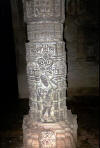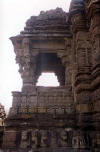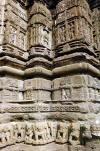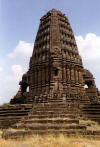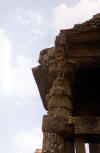


![]() Gondeshvar Temple Near Nasik
Gondeshvar Temple Near Nasik ![]()
History of Region:
Govindeshvar or Gondeshvar
temple is situated about 26 Kilometres from Nasik .The earliest historical mention of Sinnar appears to
be Sindiner in a copper-plate grant of 1069 A. D. Sinnar was known as Sindinagar
or Seunpura and was ruled by Bhillama III of the Yadava family . In 1025 AD the
Mahasamanta Bhillama III was ruling his hereditary province of Seundesa as
feudatory of the Western Chalukya King Jayasimha II .Tradition ascribes the
founding of the town to a Gavali ( Yadava) chief by name Rav Shinguni, perhaps
Seunendu of the copper-plate about 800 years ago. His son Rav Govinda is
supposed to have built the great temple of Govindeshvar or Gondeshvar at a cost
of 2 lakh of the currency of that period . It may have been named after
Govindaraja a Yadava Prince of the 12 th century .Yet another tradition assigns
the building to Govindaraja, a Yadava king who ruled about the beginning of the
twelfth century A. D. Be it as it may, it is still the largest, most complete
and the best preserved example of mediaeval temples of the Deccan built on a
variation of the Indo-Aryan style, which had penetrated into a part of the
Deccan during the middle ages.
Gondeshvar Temple:
Gondeshvar or Govindeshvar temple of the numerous shrines in Sinnar, the ones sacred to Gondeshvar and Aieshvar are the most significant as also antique. To the north-east outside the town stands the splendid black-stone temple of Gondeshvar weathered by the wind and sun of centuries. It is still the largest, most complete and the best preserved example of mediaeval temples of the Deccan built on a variation of the Indo-Aryan style, which had penetrated into a part of the Deccan during the middle ages. It is a Shaiva Panchayatan, or a group of five temples, within a large enclosure, the central shrine being dedicated to Shiva, and the remaining four around it to Parvati, Ganapati, Surya and Vishnu.
The central shrine consists of the sabhamandap or the assembly hall and the gabhara or the towered cell enshrining the Shiva linga. It is beautifully proportioned and entered by three imposing and pillared porticos. The design of the shikhars or the towers and the pillars are original and unlike those of any other region. The temples of the Deccan are different from other northern or Indo-Aryan temples, in that the shikhar does not have turrets or urushringas grouped around the lower part of the structure. Instead the shikhara has a distinct vertical band rising upwards along each of its angles and taking the form of a spine or quoin. The space between the quoins is filled with smaller reproductions of the shikhara. The pillared hall itself, though small, is elegant and is one of the finest in this part of the country. Facing the main or the eastern entrance is a Nandi pavilion housing a stone-bull, Shiva’s vehicle. An unusual feature of the Gondeshvar temple, and one peculiar to this part of the Deccan, is the deep projections and the recesses on the wall surfaces. Rising upwards these catch the light or fall in deep shade and to counterpart this upward trend a series of horizontal mouldings have been laid across the entire composition.
Many of these mouldings have a knife-edge section called koni. Koni-mouldings are found not only on the walls but are particularly noticeable on the pillars. On its walls are sculptured scenes from the Ramayana, gods and goddesses, apsaras and myriad other figures, male and female, from the Hindu mythology. Many of the missing panels, however, appear to have been deliberately removed by curio-hunters. The sculptures, though well executed, do not stand comparison with the best of Indian carving and authoritative references tell us that it shows a decline in style at this date. The real beauty of Gondeshvar temple lies in its symmetrical disposition on a moulded and stepped platform only 125' X 95'. Lying around are the crumbling remains of the temple walls and the entrance gate. It is still frequented by worshippers.
![]() Photo Gallery : Gondeshvar Temple
Photo Gallery : Gondeshvar Temple
![]()
(Click on the thumbnail to view photograph)
![]() How To Reach ?
How To Reach ? ![]()
Road map (Click on the thumbnail to view photograph)
Sinnar : Sinnar is small town in Nasik district in the state of Maharashtra , India .Reachable By road : 230 Kms from Mumbai , 180 Kms from Pune Nearest Railway Station : Nasik road ( 20 Kms ) For stay : Hotels , Government Guest houses are available at Sinnar , Nasik Other Attractions at Sinnar : " Gargoti " Asia's first Mineral Museum in sinnar , Aishvaryeshwar or Aieshvar Temple and several other buildings of Maratha period . Nearest Locations : Nasik , Shirdi .
History of Sinnar :
The earliest historical mention of Sinnar appears to be Sindiner in a copper-plate grant of 1069 A. D. Tradition ascribes the founding of the town to a Gavali chief by name Rav Shinguni, perhaps Seunendu of the copper-plate about 800 years ago. In the seventeenth century it became the headquarters of the Chief Officer of the Emperor of Delhi in these parts and its population greatly increased. Later still it was the seat of the government of Amritrav Deshmukh, who was appointed head of fourteen sub-divisions by the Moghal Emperor. In his time the population of Sinnar still further increased. He is also said to have built the aforementioned town walls and laid a masonry dam across the river. His vada or palace, now in partial ruins, was perhaps the largest building in the town then, and contained within its outside walls many separate collections of houses. About the year 1790, Sinnar appears in Maratha records as the headquarters of a sub-division in the district of Sangamner with an yearly revenue of about Rs. 29,000. Sinnar also figured mildly in the revolutionary activities that culminated in the 1857 War of Independence. In November 1822 a band of forty insurgents assembled at Sinnar and were joined by twenty-five more. Their leader, one certain Krishna Kuver gave out that their object was to overthrow the British authority from Kankari, a village about 16 km. south-west of Sinnar and take possession of it; but this was only small part of a large plot. Unfortunately all were captured at Kankari and on surrendering their arms and horses, were released.
I like to thank Mr Kiran Kharade , JK and Volker Thewalt of India Archaeology group for their guidance in collecting information about the temple .
Related Link : The palm leaf : a look at india's past , 6th january 2006





